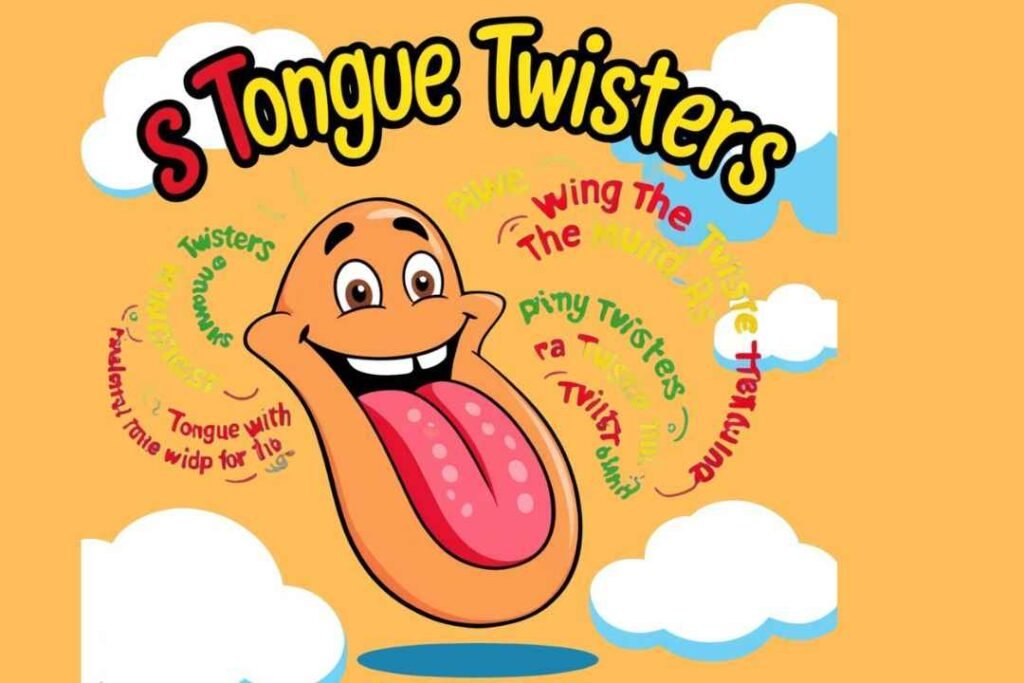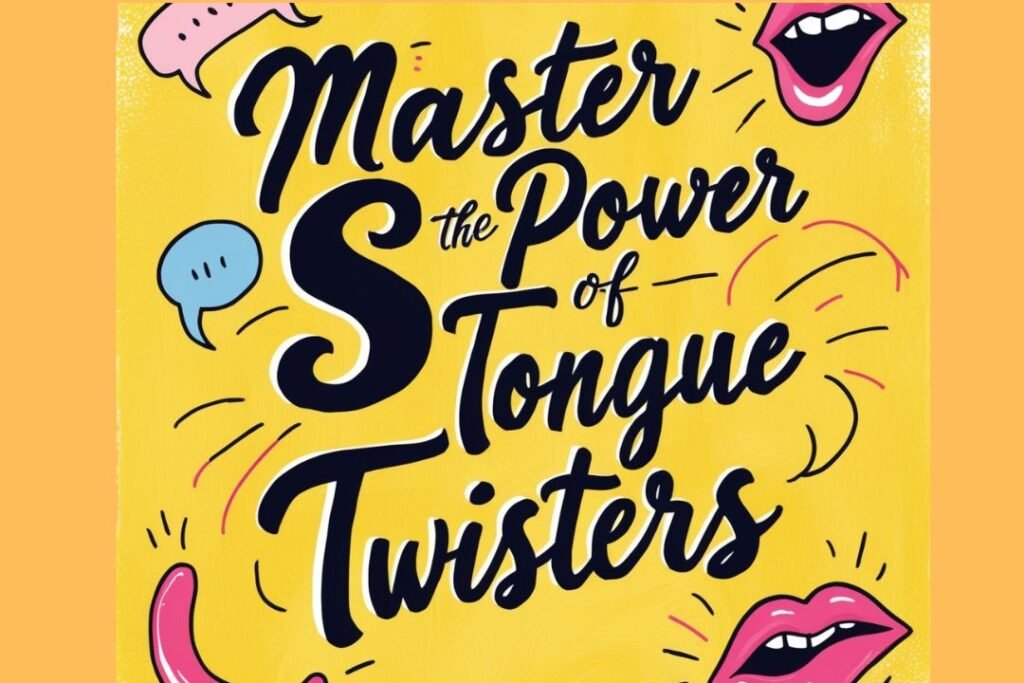Engaging in playful and linguistic exercises like tongue twisters can be a valuable way to improve your pronunciation skills. These classic phrases, known for their repetitive and intriguing sequences of similar sounds, are more than just entertaining. They serve as effective tools for enhancing verbal agility and diction clarity. By navigating through these repetitive obstacles and rhythmic obstacles, learners can swiftly and accurately promote precision in their language skills. These tongue twisters also foster phonetic awareness, which is crucial for sharpening the ability to differentiate similar sounds and improve articulation and enunciation. The importance of these exercises in speech therapy cannot be overstated, as they provide a fun and enjoyable method to enhance communication.
Beyond their educational value, tongue twisters hold a special place in social settings, classrooms, and even cultural traditions. These versatile tools are popular choices for games and activities that bring about laughter and camaraderie. Attempting to master these intricate phrases can be a shared experience that connects people across generations and time. The cultural significance of these oral traditions and folklore is evident in how they weave through our tapestry of language, offering both educational entertainment and a timeless appeal. As learners grapple with these challenges with a positive attitude, they not only refine their linguistic dexterity but also become part of a rich human tradition that has endured through generations. These artifacts of language, with their nuances and flair, are not just exercises in mastering speech but also puzzles that hold a timeless amusement for all.
Master the Power of S Tongue Twisters
For those learning English, mastering pronunciation can be a daunting challenge. However, the playful world of tongue twisters—those tricky sequences of similar sounds—provides a unique method to improve and perfect your speech. Tongue twisters, ranging in sizes and difficulties, have been used for decades not only in speech therapy but also by actors, politicians, and news anchors to sharpen their enunciation before going live. These exercises demand repetition of difficult phrases, forcing the mouth and mind to practice together, which significantly enhances articulation.
In a typical classroom setting or during any speech therapy session, tongue twisters that start with S serve as both warm-up and cool-down activities, helping students tackle the more complex aspects of English pronunciation. By repeatedly uttering phrases such as “Silly Sally swiftly shooed seven silly sheep,” learners build flexibility in their speech and become better equipped to navigate between voiced and voiceless sounds, like the sibilant ‘s’ and the buzzing ‘z’. This repetition not only refines the student’s ability to alternate between difficult sounds but also promotes a sense of amusement and engagement, turning a rigorous practice into an enjoyable activity.
Sharpen Your Skills with Silly and Slippery S Tongue Twisters
Tongue twisters are not just fun; they are a fundamental tool to enhance diction, enunciation, and overall communication. Focused on the letter ‘S’, these phrases and sentences are crafted to challenge your ability to articulate sounds accurately without a stumble. Take, for instance, “Sally sells seashells by the seashore,” which not only uses the repetitive ‘S’ to bond friends and family through a lighthearted challenge but also serves as a warm-up for public speakers, actors, and singers. The phrase “Susan shines her shoes with slippery snails that slid silently seaward” is another example that blends language barriers and speech impediments into a playful activity.
Additionally, these games of wordplay are famous among all ages and can be a great way to pass time during car rides or group gatherings. They not only offer entertainment but also provide a platform for practicing speech techniques. From “Sam sipped sudsy soda” to the slightly more complex “Peter Piper picked a peck of pickled peppers”, each tongue twister pushes you to articulate each sound and word more clearly and quickly, turning a simple activity into an effective language exercise.
You might enjoy reading: Discover How Cream Rises to the Top:Definition & Key Examples
Top Tongue Twisters with the Letter ‘S’
Tongue twisters that feature the letter “S” are not only challenging but also a lighthearted and fun way to sharpen pronunciation skills. These phrases focus on the repetition of the “S” sound, helping to train your mouth and tongue to produce sounds quickly and accurately. Perfect for both solo practice and group activities, they bring friends and family together in a joyful learning experience. Whether you’re looking to improve your speech or just want to challenge yourself, these tongue twisters offer a unique blend of learning through repetition.
Here are some examples that highlight how the “S” can be weaved into sentences to focus on pronunciation:
- She sells seashells by the seashore.
- Silly Sally swiftly shooed seven sheep.
- Six slippery snails slid slowly seaward.
- Susie works in a shoeshine shop where she shines and where she sits.
- A swan swam over the sea, swim, swan, swim! Well swum, swan!
These examples not only improve pronunciation but also make the practice engaging and enjoyable, turning it into a game that can be enjoyed in various social settings.
What’s the Famous Tongue Twister Full of ‘S’ Words?
One of the most challenging and fun tongue twisters that is packed with the letter ‘S’ is “She sells seashells by the seashore.” This phrase not only features repetition of ‘S’ sounds but also tests your ability to articulate these sounds quickly and accurately. It’s a great example of how tongue twisters can help improve pronunciation through repetition and practice. This particular tongue twister has become a classic exercise for those looking to enhance their enunciation and is surely one you might have tried if you’ve ever dabbled in improving your speech with tongue twisters.
Which Tongue Twisters Make You Say the ‘S’ Sound Repeatedly?

Tongue twisters are playful exercises designed to improve articulation and pronunciation by challenging you to pronounce repetitive and difficult sounds rapidly and accurately. These combinations of words often revolve around a specific theme or sound, such as the ‘S’, which requires careful movement of the tongue and mouth. A well-known example is “She sells seashells by the seashore,” which helps strengthen control over the ‘S’ sound. These exercises not only help sharpen your speech but also provide information on how related sounds can be managed within various word combinations. They are particularly useful for those looking to focus their practice on mastering specific sounds in a topic-related and engaging manner. Keep in mind that coming back to practice these twisters regularly can significantly enhance your speech skills.
What is the 1st hardest tongue twister?
Determining the hardest tongue twister is largely subjective and can vary from person to person, often influenced by one’s native language and accent. However, one of the most commonly mentioned and challenging examples is “The sixth sick sheik’s sixth sheep’s sick.” This twister involves a complex mix of ‘s’ and ‘sh’ sounds, making it exceptionally difficult to repeat rapidly without stumbling. The difficulty of this phrase lies in its ability to challenge speakers to navigate through similar, yet distinct, sounds, testing their pronunciation skills to the limits.
What are tongue twisters with Z and S?
Tongue twisters that feature both ‘Z’ and ‘S’ sounds offer a unique challenge to those trying to sharpen their pronunciation skills. For instance, “Zebras zig and zag zealously seeking zigzags,” combines both sounds in a lively manner that really tests your speech agility. Another twister, “Sally swiftly shooed seven silly sheep,” blends the softness of the ‘S’ with the rhythm of the sentence. Adding more zest, “Zara’s zesty zinnias zestfully swayed in the breeze,” and “Six slippery snakes silently slithered sideways,” further challenge you to articulate these sounds clearly and rapidly. “Zeke’s zeppelin soared swiftly, zigzagging through the streams,” is yet another example where these consonants come alive, pushing your ability to switch quickly and accurately between the buzzing ‘Z’ and the hissing ‘S’.
What are 10 tongue twisters?
A Selection of Ten Terrific Tongue Twisters
Tongue twisters are not only fun but also essential tools for mastering the art of pronunciation. Here are ten classic examples that challenge both novices and seasoned speakers:
- “She sells seashells by the seashore.” This classic tests your ability to handle the ‘s’ sound.
- “Peter Piper picked a peck of pickled peppers.” A popular twister that mixes ‘p’ and ‘k’ sounds.
- “How many pickled peppers did Peter Piper pick?” Continues the challenge from the previous twister.
- “Unique New York, you need New York, you know you need unique New York.” Focuses on quick ‘n’ and ‘y’ transitions.
- “Fred fed Ted bread, and Ted fed Fred bread.” A playful mix of ‘f’ and ‘d’ sounds.
- “A black bug bleeds black blood; what color blood does a blue bug bleed?” Great for practicing ‘b’ and ‘l’ sounds.
- “Six slippery snails slid silently seaward.” Combines ‘s’ and ‘l’ sounds in a smooth flow.
- “Susie sits shinning shoes where she sits she shines, and where she shines she sits.” This tests your ‘sh’ and ‘s’ sounds.
- “Swan swam over the sea, swim, swan, swim! Swan swam back again. Well swum, swan!” A lovely rhythmic challenge.
- “Nine noiseless, nose-nudging narwhals.” The ‘n’ sound is front and center in this delightful tongue twister.
Each of these tongue twisters provides a unique challenge to your pronunciation skills, helping to sharpen your articulation and enunciation through rhythmic repetition.
What Are the Most Popular Tongue Twisters with the Letter ‘S’?
Tongue twisters are a fun and effective way to enjoy and master the art of pronunciation, especially when they involve the slippery ‘S’ sound. Here are several examples:
- “She sells seashells by the seashore.” This classic challenges you to articulate S sounds clearly and quickly.
- “Six slippery snails slid silently seaward” – This twister practices S sounds and blends in L sounds, enhancing its difficulty and effectiveness as a speech exercise.
- “Susie sits shining shoes where she sits she shines, and where she shines she sits,” – This one surely knows how to twist your tongue with its careful distinction between S and SH sounds.
- “Swan swam over the sea, swim swan swim! Swan swam back again. Well swum, swan!” – Combines rhythm and repetitive sounds to test and improve your speech dynamics.
- “Can a clam cram in a clean cream can?” – A complex combination that challenges pronunciation skills.
- “Noiselessly napping, nine noisy narwhals nose-nudge new nets,” – This twister pushes the boundaries of vocal dexterity with its intricate sounds and rhythm.
These twisters not only sharpen your enunciation but also make the learning process enjoyable, providing valuable practice in speech articulation. Whether used in a classroom setting or as a personal challenge, they offer a great way to enhance your pronunciation skills.
How Do Tongue Twisters Help Improve Pronunciation Skills?
Tongue twisters offer a unique and beneficial method to improve communication skills and diction through the repetitive and rapid repetition of similar sounds and syllables. These playful phrases test the speaker’s ability to control the movement of their tongue, lips, and vocal cords while trying to pronounce sounds and words both accurately and quickly. The challenge lies in the coordination required between the brain and speech muscles, which must work together to articulate each sound and syllable precisely and rapidly.
Engaging in this practice helps individuals not only overcome language barriers but also train their speech production muscles. It’s a way to articulate tricky consonant clusters like sibilant s, sh, sw, and sl. The succession of trying to say them repeatedly and clearly can significantly enhance speech clarity and enunciation. From personal experience, daily practice has dramatically improved my ability to articulate complex sentences during presentations, making tongue twisters not just fun but a key tool in my language learning arsenal.
You might enjoy reading: GNG Meaning in TikTok and Text: Explained in Simple Terms
How Do Tongue Twisters Aid Individuals with Speech Impediments?
Tongue twisters can significantly benefit individuals with speech impediments, such as stuttering or lisping, by providing a structured method to practice and improve their articulation and pronunciation. The repetitive nature of these phrases helps in mastering the production of specific sounds and syllables, making them a key tool in speech therapy. Practicing tongue twisters encourages coordination and muscle control of the tongue, lips, and vocal cords, leading to clearer and more fluent speech.
For example, phrases like “Walter walked with Wendy, wondering if Wally was whistling,” help target and train the challenging W sounds, while “Fuzzy Wuzzy was a bear, Fuzzy Wuzzy had no hair” focuses on the F sounds. These engaging and fun exercises not only boost speaking abilities but also build confidence in pronouncing difficult patterns. Through consistent practice, individuals find these structured patterns less daunting and more enjoyable, leading to a routine that fosters success in their communication skills.
How Often Should You Practice Tongue Twisters to Improve Speech Impediments?
For individuals with speech impediments, the frequency of practicing tongue twisters can greatly influence their progress. Regular and consistent practice is crucial; however, the severity of the impairment and personal progress under the guidance of a speech therapist often dictate the specific frequency and intensity of exercises. Typically, short sessions conducted multiple times a day are more effective than longer, less frequent sessions. These regular, targeted practices help reinforce learned patterns and gradually increase complexity, improving not only pronunciation but also confidence in natural communication. As complexity improves, incorporating these exercises into regular conversations helps generalize the skills to real-world scenarios, making everyday communication smoother and more accurate. Working closely with a therapist to tailor and monitor the routine ensures that the exercises are aligned with unique needs and can be adjusted accordingly, maximizing the potential for meaningful progress.
Can Tongue Twisters Enhance Communication Skills Across Multiple Languages?
Tongue twisters are not only fun but also beneficial for improving communication skills in multiple languages. By practicing these challenging phrases, individuals can enhance their articulation and pronunciation across different linguistic contexts. Each language has its own unique phonetic characteristics, and tongue twisters can help you distinguish and produce these specific sounds more accurately. This practice boosts oral proficiency by improving clarity, rhythm, and fluency through the rapid repetition of language-specific sounds. Additionally, mastering tongue twisters in various languages contributes to greater confidence and a deeper understanding of the cultural and linguistic nuances that are crucial for effective communication. Regular exposure to tongue twisters, combined with immersion and interaction with native speakers, forms a comprehensive strategy for enhancing communication skills in any language. Sharing these experiences on platforms like Facebook, Twitter, and Pinterest can also boost speaking confidence and allow for a broader exchange of linguistic context and cultural nuances.
What are the benefits of practicing tongue twisters for language learners?
Practicing tongue twisters helps language learners improve their pronunciation, articulation, and fluency. It strengthens the muscles involved in speech production and helps learners become more confident and accurate in their speaking abilities, especially when learning new sounds or difficult language patterns.
Can tongue twisters be used in speech therapy for stuttering?
Yes, tongue twisters are often used in speech therapy as a tool to help individuals with stuttering. They promote slow, deliberate speech patterns and improve muscle coordination. By repeating challenging sounds and patterns, those with stuttering issues can develop better control over their speech.
How can tongue twisters improve pronunciation in non-native speakers?
Tongue twisters focus on difficult sound combinations, which non-native speakers might struggle with. Regular practice helps them master tricky consonants and vowels, improving clarity and fluency. Over time, this leads to better pronunciation and more natural speech in their new language.
How often should you practice tongue twisters to see improvement?
To see noticeable improvement, it is recommended to practice tongue twisters daily for 5-10 minutes. Consistency is key to training your mouth muscles and improving your articulation, especially when working on specific sounds or speech issues.
You might enjoy reading: Maximal vs Maximum: Discover the Crucial Difference



